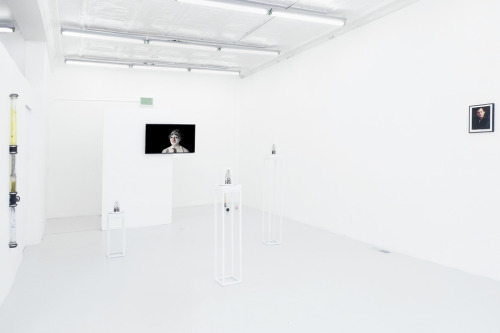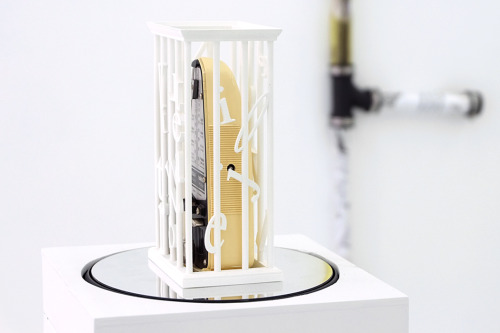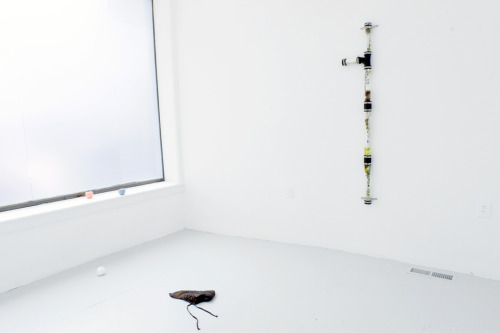To safely light one’s hand on fire, first apply a sodium polyacrylate polymer. While water would run right off one’s hand, the polymer holds large amounts of water in gel form, protecting the skin from the flame. The promotional image for Watching Things Burn depicts a hand lit on fire using this method. The show’s poster, coupled with the title, tells me much about what I should expect to see: controlled chaos, staged fire, and the intensity of heat both with and without the burn.

Izabelle New’s candle and wax works are the most immediate reference to the show’s title. New’s cast apple and asparagus candles are scattered throughout the exhibition and were burned during the opening reception. No longer lit, the wax is frozen in action as it puddles, drips, and spills out onto the floor. Most noticeably, at the entrance, a wax candle is melted down to an indistinguishable mound of goo, while its handsome counterpart—a candle asparagus, titled for Julian—stands upright across the room. The potential of the candle is to melt away.
Unlike the candles, New’s work near the gallery entrance is concerned with preservation, rather than entropy. Fully bloomed chives covered in wax rest on a windowsill. Tension is placed on a single flower that has fallen off its bloom. The title of the work, your laughter comforts the dead, is a line from the poem A Tree Within by Octavio Paz. Paz uses the tree as a metaphor for the mind and spirit, which both grow and die—“born in the memory of an old women/ and you turn it into a flaming carnation.”
Jason Benson’s Untitled works share (but complicate) this notion of preservation. Clear tubes mounted with plumbing hardware contain paper with printed notes, moss, plant debris, and piss-yellow resin. The notes on paper are preserved in a staged temporality with resin bubbled in faux movement and plant debris that suggest rather then show natural growth from the enclosed notes.
With the tubes mounted flat against the wall, only sections of the printed notes are legible. One note reads, “Natural_Born_Killers Directors_Cut_ [1994].” The referenced film is a dark comedy about two murderers and lovers who are glorified by the mass media. Predating the popularity of reality tv, Gale, a tabloid journalist follows the couple for a show called American Maniacs. Gale gives a live television report as Mickey confessed to his crimes followed by a prison break in which people are beaten and killed. Now it is common for mass murders to use social media to confess and elaborate on their crimes. Take for instance Randy Janzen, who posted on facebook after killing his wife, sister, and daughter, “Rest in piece my little family. Love Daddio.”
Another piece of visible text in Jason Benson’s tubes, “You: fruit / flesh combination” points me back to New’s candles, reinforcing bodily connotations. Though these two works are formally disparate, they couple nicely.

If Izabelle New’s work embodies the show’s reacurring motif—the potential to burn, melt away, and unbecome—Sydney Shen’s and COBRA’s works sets the tone. Placed adjacent from each other they sing in disharmony. Sydney Shen’s three works titled Lament Config. consist of metronomes inside of 3d printed boxes rotating on a mirrored platform. Each metronome beats at its own pace, displayed at three different heights. The work points to theatricality, performance, and musicality. The titleLament Config., comes from a fictional puzzle box popularized by the Hellraiser movie series. In the film, solving the puzzle box transports you to a demonic dimension, a place of endless pain and suffering. This is precisely where I am transported viewing COBRA’s video The Future is Wild – CRY CRY CRY -. In the video, a clown whimpers, ranging from a light sobbing to a theatrical hyperventilating cry. Equally exaggerated are the clown’s features, including overdrawn lips, eyebrows, and a prosthetic nose. The two works sing together. The metronomes keep time, and the clown cries eternally.
The most intense piece in the exhibition is Zachary Susskind’s Malcolm X Blvd, a flattened shoe that sits in the middle of the second room in the gallery space. The shoe is as flat as the floor with its shoelaces sprawled out like limbs from a chalk outline in a crime scene. The work is poetic and requires little explanation.

Alex Perweiler and Chloe Maratta’s works are the most disjointed of the show, but relate to the blurb released by Springsteen, which addressed the show as addressing “the modes of measuring performance through varying media.” Both works imply a performance.
Alex Perweiler’s work Role, an 8 x 10 headshot of the artist, feels too close to David Robbins’ work Talent to be a mere coincidence. Talent consists of eighteen 8 by 10 headshots of (now) well-known artists including Jenny Holzer, Cindy Sherman, and Jeff Koons. In an interview with Susan Morgan, David Robbins stated he chose talent as the title because, “Artists [… are] people involved with difficult intellectual, political, and moral stances, and on the other hand, they are public figures who function as entertainers.” Perweiler’s piece, made nearly thirty years after the original, asserts that the role of entertainer now overshadows any other artistic purpose.
Chloe Maratta’s D.I. dress is an artifact of a character and performance that is never seen. The dress is white, hand sewn, screen-printed, and smudged with a grey residue. A badge with the numbers “88” is sewn to the back of the dress. The work is too cryptic for me to understand or to relate to other works in the show.
Watching Things Burn is open through July 25 at 502 W. Franklin Street, Baltimore, MD. Images courtesy of the gallery.